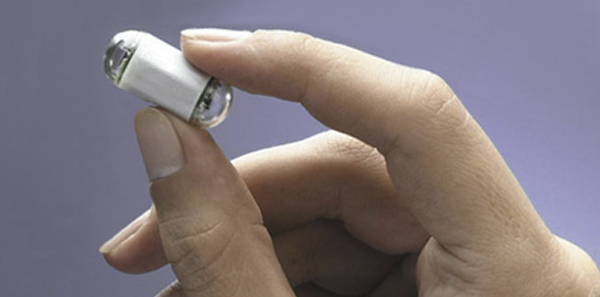
A non-invasive diagnostic technique
The small intestine is usually regarded as being the most inaccessible part of the digestive tract to examine. For many years, radiological studies with barium contrast media have often prevented clear images being obtained of existing lesions.
The ENDOSCOPIC CAPSULE technique was first used in Spain in 2001. It is a new, minimally invasive technique, simple and well tolerated by patients, used for the diagnosis of diseases of the small intestine and to ascertain the appropriate medical or surgical treatment.
The method consists in filming the small intestine by getting the patient to swallow a capsule, about the size o fan ordinary pill (26 mm x 11 mm), and containing a small camera. Once swallowed with a small amount of liquid, the capsule takes 2 photographs per second, which are captured b sensors placed on the patient.
Recording takes around 6 to 8 hours. After removing the recorder, it is connected to a special device for downloading the images, which are later analyzed by a specialist. Finally, the capsule is expelled with the faeces and is not reused for any other patient.
The main indication for this technique is normally digestive tract hemorrhage of unknown origin following and unresolved endoscopic study of the upper digestive tract because of either obscure or occult bleeding. But it is also indicated for a suspected small intestine tumor, intestinal polyposis, suspected Crohn’s disease, impairment of the intestine due to pharmaceutical drugs (iatrogenic bowel injuries), malabsorption of unknown cause or in the progress of a celiac disease and in cases of chronic post-radiotherapy damage.
Initial counter indications may be suspected intestinal obstruction and pseudo-obstruction, motor changes, mainly in diabetic patients, the existence of Zenker's diverticulum, pregnancy, and patients with any kind of electro cardiac device.
Complications are unusual but as with any diagnostic technique, they may occur. The main complication is retention of the capsule in áreas of bowel strictures. In cases where there are ground for suspecting complications due to obstruction of a PATENCY CAPSULE, a similar-sized biodegradable capsule is given before administration. If this capsule is expelled deformed or if it is no eliminated (there Will be no problem as the capsule decomposes in a few hours), the study with the video capsule is counter-indicated.
The endoscopic capsule provides the option of achieving a complete exploration, which is non-invasive and the patient does not take up a hospital bed. It is a great technological leap forward in the development of digestive endoscopy.
Dr. Matas Navarro-Dr. Suárez Guijarro-Digestive Medical Surgery Unit
The information published in this media neither substitutes nor complements in any way the direct supervision of a doctor, his diagnosis or the treatment that he may prescribe. It should also not be used for self-diagnosis.
The exclusive responsibility for the use of this service lies with the reader.
ASSSA advises you to always consult your doctor about any issue concerning your health












